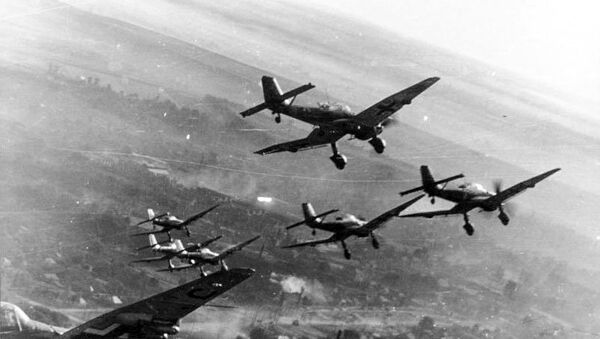The sound of the Stuka’s air sirens is unmistakable; if you’ve ever seen a film with a prop-driven plane in it, you probably heard it as an added sound effect. However, the noise isn’t natural: it’s made from a special device mounted under the plane that produces its characteristic whine when air is rammed through it at a sufficient speed - for example, when accelerating during a steep dive-bombing attack.
The Nazis called the device a “Jericho Trumpet,” after the Biblical story in the Book of Joshua in which the Israelites caused the walls of Jericho to crumble by blowing their ram’s horns at it - after God told them to, of course. However, when the CIA tried to replicate the device in the 1950s, it called it a Jericho Horn or, alternately but perhaps no less appropriately, the “Screamer Project.”
The purpose of the device for both the Germans and Americans was purely psychological: to spread fear among the population under attack, in line with prevailing theories about the ability of aircraft to decide wars through terror bombing.
However, as The War Zone relays in a play-by-play retelling, the CIA brains who wanted a Jericho Trumpet for themselves didn’t know how to make one and embarked on an epic journey trying to chase down a preserved Stuka that still had one so they could copy its design.
The "Trumpets of Jericho," terror sirens used by the Nazis on their Stuka dive bombers. They activated at high speeds to cause a characteristic high-pitched, unnerving whine. pic.twitter.com/fxlwAvaCDl
— Morgan Artyukhina (@LavenderNRed) April 10, 2020
By 1958, the CIA researchers had two workable models for testing, with theirs including an adjustable “iris” to control air flowing into the Jericho Horn.
According to a series of handwritten notes preserved by CIA archivists, they wanted a device that could produce a terrifying and painful sound while the aircraft was flying at roughly 300 mph and just a few hundred feet off the ground. The idea was presumably to make low and fast passes over enemy positions or civilian areas, sowing discord and discomfort.
The device was hooked up to an AT-11 Kansan training aircraft and later a Cessna 180, but after numerous tests, they couldn’t get it to make a sound louder than 108 decibels, which The War Zone notes is about as loud as a chain saw - not exactly terrifying. The scientists had set a goal of 170 to 180 decibels.
It seems testing continued into 1959, but by the spring of 1958, the CIA’s curiosity had apparently wandered to other projects.
"At present the 'Jericho Horn' does not satisfy this requirement and it is doubtful that continued effort will achieve this end," says a report dated March 31, 1958.
However, the US military did adopt other weapons of psychological warfare based in aircraft, including loudspeakers attached to helicopters. Sometimes these were purely obnoxious, such as those used to besiege Panamanian President Manuel Noriega when he sought refuge in the Vatican embassy after the US invaded Panama in 1990 to depose him.
At other times, they broadcast seemingly sympathetic messages to enemy forces; others, such as “Operation Wandering Soul” during the Vietnam War, aimed at sheer horror. This clever ruse played upon the popular Vietnamese belief that the souls of people not buried in their homeland wander aimlessly in suffering, and the US Army played eerie sounding recordings to trick National Liberation Front fighters into thinking the souls of the dead were among them.



